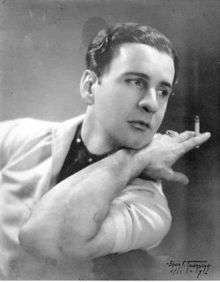George Quaintance
George Quaintance (June 3, 1902 – November 8, 1957) was an American artist, famous for his "idealized, strongly homoerotic"[2] depictions of men in mid-20th-century physique magazines.[1] Using historical settings to justify the nudity or distance the subjects from modern society, his art featured idealized muscular, semi-nude or nude male figures; Wild West settings were a common motif.[3] His artwork helped establish the stereotype of the "macho stud" who was also homosexual,[4] leading him to be called a "pioneer of a gay aesthetic".[5] He was an influence on many later homoerotic artists, such as Tom of Finland.[6]
George Quaintance | |
|---|---|
 | |
| Born | June 3, 1902 |
| Died | November 8, 1957 (aged 55) |
| Occupation | Artist, dancer, designer of stage sets, interiors and New York department store windows; make-up artist, hairstylist, and portrait artist.[1] |
| Spouse(s) | Miriam Chester (1929) |
| Partner(s) | Victor Garcia |
| Parent(s) | Ella Belle (mother) George Quaintance (father) Nannie (older sister) |
Biography
Quaintance was born in Page County, Virginia,[1] and grew up on a farm, displaying an aptitude for art.[4] Even as a teen, Quaintance has been described as "obviously and actively homosexual", despite being closeted. At the age of 18 he studied at the Art Students League in New York City, where, as well as painting and drawing, he studied dance, which led to him meeting and briefly marrying Miriam Chester.[1] In the 1930s, he became a hairstylist.[7][8]
His first art assignments were anonymous advertising work, but by 1934 he had begun to sell freelance cover illustrations to a variety of "spicy" pulp magazines, such as Gay French Life, Ginger, Movie Humor, Movie Merry Go-Round, Snappy Detective Mysteries, Snappy Stories, Stolen Sweets, and Tempting Tales. These were sold at burlesque halls as well as under-the-counter at discreet newsstands. These illustrations, which were clearly influenced by Enoch Bolles, were often signed "Geo. Quintana".
In 1938, he returned home with his companion Victor Garcia, described as Quaintance's "model, life partner, and business associate", who was the subject of many of Quaintance's photographs in the 1940s.[1] During that time he was art editor for Joe Bonomo, who published women's magazines such as Glorify Your Figure, Beautify Your Figure, and Your Figure Beautiful.[9][10] In 1951, Quaintance's art was used for the first cover of Physique Pictorial, edited by Bob Mizer of the Athletic Model Guild.[11]
In the early 1950s, Quaintance and Garcia moved to Rancho Siesta,[6] in Phoenix, Arizona, which became the home of Studio Quaintance, a business venture based around Quaintance's artworks.[12] In 1953, Quaintance completed a series of three paintings about a matador, modeled by Angel Avila, another of his lovers. By 1956, the business had become so successful that Quaintance could not keep up with the demand for his works.[13]
Quaintance died of a heart attack on November 8, 1957.[11][13]
References
- Quaintance, George (1902-1957) p.1 Archived July 13, 2009, at the Wayback Machine
- Joseph W. Slade (2001). Pornography and sexual representation: a reference guide, Volume 2. Greenwood Publishing Group. p. 545. ISBN 0-313-31520-5.
- Christopher Shaun Nealon (2001). Foundlings: lesbian and gay historical emotion before Stonewall. Duke University Press. pp. 132–135. ISBN 0-8223-2697-3.
- Emmanuel Cooper (1986). The sexual perspective: homosexuality and art in the last 100 years in the West. Routledge. p. 233, p.236. ISBN 0-7100-9635-6.
- País, Ediciones El (July 4, 2010). "Reportaje | Pionero de una estética gay". El País (in Spanish). ISSN 1134-6582. Retrieved February 2, 2019.
- "Quaintance, George (1902–1957) p.2". Archived from the original on June 4, 2011. Retrieved August 29, 2009.
- George E. Haggerty (2000). Gay histories and cultures: an encyclopedia. Taylor & Francis. p. 1108. ISBN 0-8153-1880-4.
- "Catalog". pulpartists.com. Retrieved February 2, 2019.
- "More Lost Works". www.georgequaintance.com. Retrieved June 8, 2019.
- "The Groundbreaking Kitsch Cowboy Art of George Quaintance". Messy Nessy Chic. June 6, 2018. Retrieved June 8, 2019.
- "George Quaintance's Photos in Paris' Exhibition". gay-news.com. Retrieved February 2, 2019.
- "FindArticles.com | CBSi". Retrieved February 2, 2019 – via Find Articles.
- "Quaintance, George (1902–1957) p. 3". Archived from the original on June 4, 2011. Retrieved August 29, 2009.
Further reading
- Furtado, Ken (2013). Quaintance : The Short Life of an American Art Pioneer. P & Q Press. p. 156. ISBN 1893068196. Retrieved July 16, 2016.
- Mizer, Bob, ed. (1997). Complete Reprint of Physique Pictorial, 1951–1964. Cologne: Taschen.
- Quaintance, George (August 2003). The Art of George Quaintance (3rd ed.). Janssen Verlag. ISBN 978-1-919901-10-7.